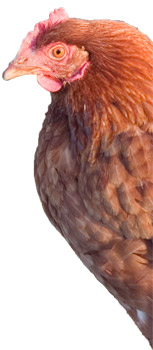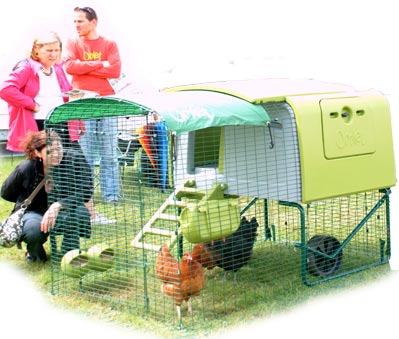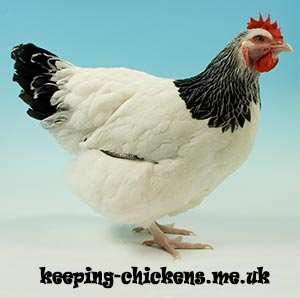Keeping a few chickens in the back yard really is quite straight forward; however there are some things to consider in order to get the right sort of birds for your situation and to keep them in the best possible health to get the most enjoyment out of keeping them.
This page hopes to get you thinking about the types of chickens and their requirements.
Choosing a breed
There are quite literally hundreds of different breeds of chicken to choose from and out of these, many have slightly different requirements.
Some breeds of chicken come only as Large Fowl, and others are also available as Bantams which are a smaller version that look the same. The Orpington for example is available in both large and bantam sizes but the Cochin is only available as large fowl.
There are a handful of ‘True Bantams’ where there is no large fowl equivalent. Examples of these are Dutch Bantams, Japanese Bantams and the popular Pekin Bantam.
Bantams tend to be quite flighty whereas the heavy breeds of large fowl often cannot fly more than a few inches off the ground. Orpingtons for example won’t usually roost very high due to their huge size and will usually just huddle on the floor of the coop.
Every breed is slightly different in the amount of eggs they lay. Typically hens that have been bred for exhibition purposes do not lay as well as utility hens. Bantams of course lay smaller eggs which some people say they prefer for taste.
Hybrids
 Hybrids are chickens that have been created by crossing pure breeds. They are typically crossed to make good layers (the hybrid to the right can lay 280 to 300 eggs!), coloured eggs or attractive hens. Some can be very attractive and they are all generally very hardy. Hybrids are produced in larger numbers that pure breeds and most of the crosses used make the males a different colour as day old chicks so that only females can be raised, therefore reducing costs by about half. A typical hybrid hen will cost you around £15 compare to £25 to £30 for a typical pure breed hen.
Hybrids are chickens that have been created by crossing pure breeds. They are typically crossed to make good layers (the hybrid to the right can lay 280 to 300 eggs!), coloured eggs or attractive hens. Some can be very attractive and they are all generally very hardy. Hybrids are produced in larger numbers that pure breeds and most of the crosses used make the males a different colour as day old chicks so that only females can be raised, therefore reducing costs by about half. A typical hybrid hen will cost you around £15 compare to £25 to £30 for a typical pure breed hen.
Hybrids are a good choice if eggs are one of your priorities although if you think you might like to hatch some eggs, remember hybrid hens do not breed true – you would need the original pure breeds to cross again in order to create more of the same thing so whilst you can hatch their eggs, you may want to consider a few pure breeds for this purpose or consider buying in eggs to hatch.
Free Range
You will of course need a chicken coop but also a secure run or area that is predator proof. A question that people always ask me is “How big should their run be?” I always say “as big as possible within reason.” Even 2 chickens kept in a 2 meter run will soon turn it to mud and get bored (which can introduce vices such as feather pecking and egg eating) but I always believe that it’s fine to provide a small run like this if you can let them out for a few hours each day to free range while you are around. This will give them a chance to forage, supplement their diet and reduce boredom.
Once chickens have settled into their new house, they will go back to it to roost every night so you can let them out in the late afternoon, knowing they will come back to roost at night keeping everyone happy! Some houses and runs have handles or wheels that make them easy to move onto fresh ground which is not only good to prevent a build up of worm eggs and disease but also provides them with a little fresh grass to graze.
Keeping Chickens in the Garden
If you have a ‘nice’ garden that you don’t want spoilt, it’s usually a sensible idea to limit their foraging. Chickens scratch at the ground, make dust baths in the dry soil, leave muck wherever they go and destroy tender young plants. If you can plant in pots, this will help and fencing off part of the garden is usually a good choice to keep them out if you have tender or precious plants. Chickens with feathered feet scratch less and bantams can clear a 6 foot fence if they want to. Heavy breeds of large fowl can be kept out with a knee high fence or box hedge. If you want to stop a bird from flying then you can clip one wing (not both).
So you have decided on the breed that’s right for you and your circumstances. Next, you will need to think about keeping them secure from predators in a suitable chicken house and chicken run – click on a link to go to that page!








What a useful site this is. Yesterday I got my first chickens …. 2 light sussex and 2 speckledy. on their first night I had to put them in the coup as they seemed as if they did not know what to do ( a ramp leads up to their house .. on the farm where they came from their house was a shed on ground level ). tonight they put themselves to bed. I thought the hens would roost on the perches to sleep but they all huddle together in the nest box. Is this the norm? As a 1st time keeper I appreciate any feedback.
Ann
They often won’t use perches at first, however you don’t want them soiling the nestboxes so move them out of them onto the perches.
The perches should be higher than the nest boxes to put them off using them to sleep in. You can block the nestboxes by putting shoe boxes or similar in them in the evening.
A question from a total noob.
My son is really keen for us to have some chickens and I think it’d be a great thing for all of us but, our garden is totally paved and I wouldn’t want to put them into the wrong environment.
Would a long, large run with wooden flooring and bark chippings or something be enough for them, or do we absolutely need grass?
Yes, you can use wood chip in the run – it’s kinder to give them something to scratch through (and daily greens) than have them on grass that turns to mud and only gathers disease and worm eggs.
I have made a hen house,as shown on one of the Internet sites, which I understand will allow for 6 to 8 chickens. I am also almost finished with the fencing which will be completed this weekend. I intend to purchase either all the same breed of chickens or pairs. I want chickens for the eggs, so which breeds do you think I should purchase assuming they will all live happily together!!!
It’s a very personal choice – I like Light Sussex as good all-rounders but you might look to see what’s available locally first, or choose a traditional breed that was kept in your area in days gone by?
Hi, thanks for the helpful website, I’m thinking of getting chickens, I have already bought a large chicken coupe with run, only problem is I have a garden full of stones and pebbles, no grass, is this ok to keep them on? My garden is completely enclosed so they would be able to free range on the day times, would tis be ok or do I need to get wood chipping or grass?
Yes, it should be fine, although make sure they are not sharp or you may get injuries on their feet. If it turns messy and hosing it down doesn’t help then you could always go to the wood chip run afterwards.
We are thinking of keeping 5 Orpington Bantums. How big would you suggest the run area should be? We intend to move it around the garden every couple of days and give the birds the run of the garden for an hour or so before dusk.
Thank you for a great website.
The answer to this question (one that I get asked a lot) is really as big as possible…. At least 1 meter squared per hen as a minimum I would say.
If you keep them in a small run then they will certainly love having an hour or two of free range before dusk each evening.